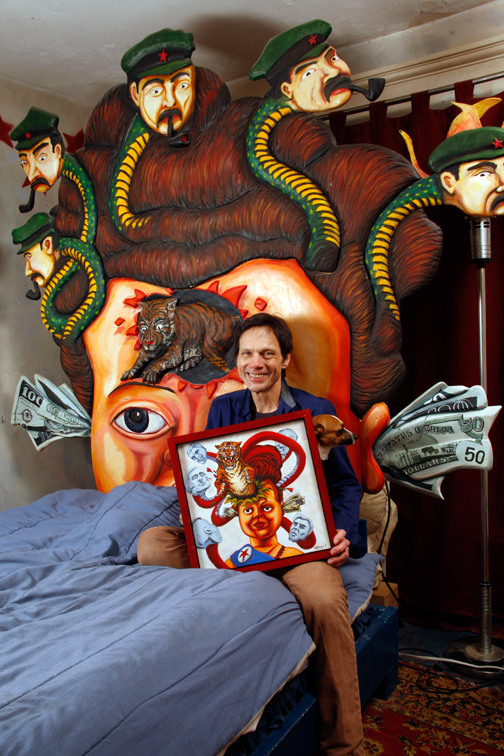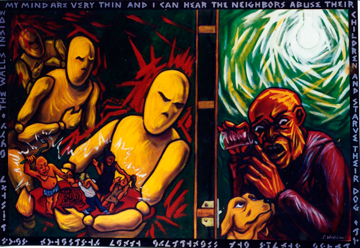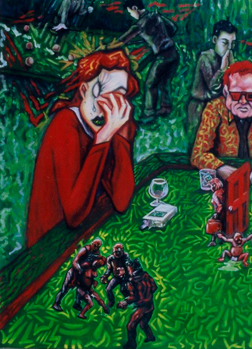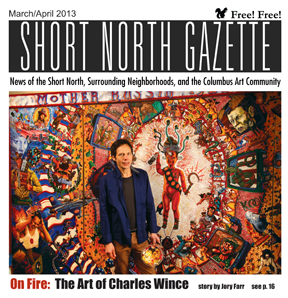
Columbus, Ohio USA
Return to Homepage www.shortnorth.com
On Fire
The Art of Charles Wince
By Jory Farr
March/April 2013 Issue
Return to Homepage
Return to Features Index
Charles Wince in his Harrison West home. Photo © Larry Hamill When people say an artist is “on fire,” they mean he or she is in touch with the burning genius of their indwelling imagination. But for artist Charles Wince, being on fire is more than a mere metaphor.
“When I was 10, a friend of mine and I were playing with fire in my parents’ garage and he spotted a battered and rusted gas can and made the assumption it was empty,” Wince, 57, says, recalling the incident that forever changed his life.
“Well, it wasn’t empty. My back was turned at the time. So I didn’t see my friend thrusting this flaming stick that he held towards the fuel can. I remember vividly the next few seconds. He jovially called out to me, ‘Hey Wince, look!’ I turned in response as he continued in a joking manner: ‘One, two...’ I saw his mischievous grin, him pushing the burning stick, a second away from contact, him completing his countdown ‘..three. B --.”
His friend never completed his last word. But Wince knew the “b” was intended as the initial sound for the word “boom.”
“I heard a thunderous roar,” Wince recalls, “and was physically thrown backwards by the force of the explosion and engulfed, immersed in flames. Perhaps some school safety film saved my life, because as I ran out of the garage I remembered to roll on the ground in order to extinguish the flames. In doing so I probably saved my life or most certainly, lessened my injuries.”
Wince pulls up the sleeves of his shirt and rolls up his jeans to show me the network of white scars that run up and down his arms and legs. He says it was a miracle that he survived. His friend sufferd burns to the inside of one arm, but was not hurt too badly due to the nature of the explosion.
“The sudden inferno that left me an invalid, unable to even walk for a time, changed me from a hyperactive, rough kid with little impulse control to a more introspective child who out of necessity began to pursue an interest that I had previously showed a bit of an aptitude for – drawing and writing short stories.”
Though the experience was nightmarish at the time, with hindsight Wince came to believe that the fiery explosion that nearly killed him also gave birth to a new person who began to think before acting – or at least more so than previously.
“I speculate that this former wild kid would have turned into a wild teenager who would eventually be locked up in jail.
Instead, that kid died the day of the fire and the more introspective person, who would become an artist, was born out of those same flames.”
The reference to rising out of the fire, the instinctive understanding of the language of initiation, comes easily to Wince. When you listen to him talk for any length of time, you sense the poetic voice inside him, illusions burned away. And his thin build, his detached yet careful demeanor belie the ferocity of his images.
Take Mother Russia Meltdown, his fierce, disturbingly funny, ongoing masterpiece that is still undergoing change after almost 20 years. The animating conflict in this 12-foot-wide triptych, which hangs in his bedroom, is the fiery inferno of Capitalism meeting the hellish inferno of Communism in a way that is both hilarious and all too real. The central image is a baby doll, located at the ground of explosion, its head stuffed with dollars. The doll’s head is a Medusa doppelganger with little Stalin faces billowing out of the writhing serpents’ bodies.
Scan the canvas and you will see other images on fire. Skyscrapers are burning next to an airplane that is also consumed with flames. And below that the artist himself is ablaze, a direct allusion to his youthful encounter with the near-fatal gas can explosion.
The Walls Inside My Mind are Very Thin and I Can Hear the Neighbors Abuse Their Children and Starve Their Dog is a disturbing look at child and animal abuse. Fire isn’t the only image in his paintings. Wince deals with racism, militarization, anxiety, abuse, sexism, runaway consumerism and the difficulty of being authentic in an increasingly inauthentic world. Scars in Bars, for example, is a savage meditation on alcoholism, and The Walls Inside My Mind are Very Thin and I Can Hear the Neighbors Abuse Their Children and Starve Their Dog is a disturbing look at child and animal abuse.
“Wince is above all, a storyteller. His single images contain an entire narrative world of his own with well-thought-out, fully developed characters and contrapuntal dialogue complete with a fictive ‘Wince arc’ that follows a beginning, a middle…and an end,” says Lori Gum, the owner of Periodisa Publishing, which features local writers, and the founder of Filigree, a Columbus-based literary journal.“Underneath the carnival of color and bold, confident lines, you will find a sharp, hard bite of social and political criticism that uses many of the iconic, pop culture images to which we are so numb and immune … in order to make us reconsider ourselves and the fleeting, shallow and insidious social and political constructs we ingest and then discard like a six-pack of Coke. Wince is not saying so much in his work as he is questioning. It is an invitation to a complex, topical discussion, not a lecture.”
The discussion is invariably funny, for one thing Wince is clear about is the power of humor, often dark, as a defense against taking things too seriously. Thus, in Mother Russia Meltdown, the Statue of Liberty has bad teeth, wraparound shades and stiff penises for a crown. Uncle Sam and Jesus, two disparate icons, are wrapped in one body. And there’s a Kennedy assassination half dollar complete with an exploding head. Communist cherubs abound, one of whom clutches a bottle of Prozac, while the other cherubs try to protect Mother Russia.
Of course, the ultimate truth is that no one is protected. A false sense of security is the only sense of security, Wince seems to be saying. And there’s humor in that position.
Wince smiles as he gleefully points out the allusions in the painting – a virtual Rosetta Stone for subsequent works. There is a soulless image of Ronald Reagan embedded in a TV, looking like a cross between a zombie and a vampire, surrounded by flying tacos.
“I try to tell an intriguing story, but there is no one truth,” says Wince. “I’m telling stories about the manipulation of fear and the greedy pursuit of more and more. But I’m also using elements of humor as a survival method.
“It’s all just a reflection of my growing up in the ‘50s, fearful of communism and its tie-in with Satanism,” Wince says. “The painting reflects the fear of both sides. But the painting isn’t just about communism and capitalism. It’s about the exploitation of fear.”
Detail from Scars in Bars, a savage meditation on alcoholism. Wince grew up in a dysfunctional family.
His early years were spent near Granville. But then his parents moved to the backwaters of rural Ohio, near Brownsville. Wince loved his mother, a charismatic, albeit “manipulative,” woman who he says was a fine, natural storyteller. But she suffered from deep, intractable depression that would leave her in complete despair.
“I would try to calm her down. My father would try to placate her,” Wince recalls. “But my mother would weep. And there were threats of suicide.”
Finally, she underwent a series of three electroshock treatments in 1964. Looking back, Wince says, he was deeply affected by his mother’s depression.
“During my teen years it alienated me.”
By his own account Wince was a withdrawn kid, quick to fight when picked on, lacking in introspection.
“I had no editor, no voice inside that said, ‘Stop! This is dangerous! I grew up as a weed. My parents did not expect very much from me, and I did not give them any reason to think otherwise.”
After his encounter with the gasoline explosion, he withdrew even further. By the time he was 14, he says, he simply didn’t speak. “I didn’t say a word in class. People would make fun of me for my voice, which was then squeaky.”
Things got even worse. When he was 16, Wince’s father tried to kill him in the family’s upstairs bathroom. The ostensible provocation was Wince’s playing of Jimi Hendrix’s “Star Spangled Banner.” But though the elder Wince maintained a mostly calm facade, there was rage underneath it.
“I just felt so alienated that I accepted his behavior,” Wince said, as if that explained the attempted murder.
Wince believes he had a nervous breakdown some time after he was burned. He’s alluded in other interviews to a few half-hearted attempts at suicide in his life. (Much later, suffering from insomnia and depression, Wince would eventually take a medication that would help.)
Given his childhood, it’s not surprising that he turned to art as an outlet. From the very beginning Wince had drawn and written stories, proof positive of an active imagination. At five, the future artist was scripting out narrative comic books with different characters.
“I was telling stories loosely based on Charles Schultz’ Peanuts. The stories were about a misfit kid like myself.”
But because of his learning disabilities – he couldn’t process letters and numbers – he never finished high school. Eventually he took a job as a part-time mail carrier, which he held for more than 20 years.
“That’s how I bought my house,” he said. “But I was a terrible mail carrier. I would constantly drop off mail at the wrong address.”
These days, his one-of-a-kind house is a shrine to his vision of the world. Every spare surface, even the toilet seat, is adorned with provocative artistic imagery. The tiled kitchen floor comes alive with swirling energy. The walls and furniture are a feast of transformative visions.
In the early ‘80s, Wince was doing murals. Then, when Barbara Haskell of the Whitney discovered Wince’s work and curated an influential show with him at OSU, the artist felt anointed. Here was the exposure he was looking for, something to lift him up. He did newspaper and magazine interviews and became well known in Columbus. But that and a failed love affair led to a year-long artistic drought.
“I was drinking too much and that got me depressed. I couldn’t sleep. I was overwhelmed.”
Eventually, Wince pulled himself out of the funk. He realized that the only things he was good at was painting. He quit his job as a letter carrier in 2002. He now had the time and desire to be an artist.
His major shows have been at Columbus’ Lindsay Gallery, at OSU, in Cleveland’s Asterisk Gallery and in Los Angeles’ Hive Gallery. But his art has not been given the showing it deserves by a major local art institution. A retrospective at the Wexner or even the Columbus Museum of Art would expose Wince to a larger, deserved audience. But the local museums generally prefer out-of-towners to native sons. So for now, Wince makes his way as an artist, selling his work at Alana’s Restaurant, even designing furniture for clients in the style of his Harrison West house, which is alive with mercurial touches of his eccentric creativity.
“I’m always working on paintings for a show,” he says, leading me on a tour of the house. “Stylistically, I’m painting both expressionistic/narrative and abstract.The two styles would not go well together. So I am planning for them to be in two separate shows.”
Meanwhile, Columbus has a protean painter with a scathing wit and a gift for creating detailed juxtapositions of improbable worlds. In Wince, the city has a fully realized artist as trickster and provocateur.Charles Wince’s art is on view at pm gallery, 1190 N. High St. and Alana’s Restaurant, 2333 N. High St.
Visit Facebook and website at www.charleswince.com
© 2013 Short North Gazette, Columbus, Ohio. All rights reserved.
Return to Homepage www.shortnorth.com



